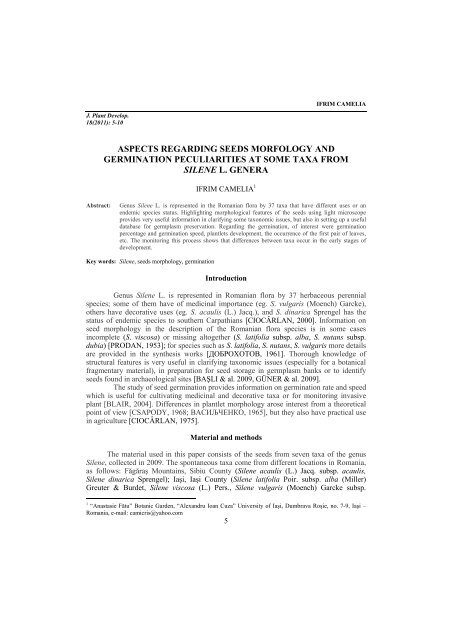Untitled - Gradina Botanica Iasi
Untitled - Gradina Botanica Iasi
Untitled - Gradina Botanica Iasi
Create successful ePaper yourself
Turn your PDF publications into a flip-book with our unique Google optimized e-Paper software.
J. Plant Develop.<br />
18(2011): 5-10<br />
5<br />
IFRIM CAMELIA<br />
ASPECTS REGARDING SEEDS MORFOLOGY AND<br />
GERMINATION PECULIARITIES AT SOME TAXA FROM<br />
SILENE L. GENERA<br />
IFRIM CAMELIA 1<br />
Abstract: Genus Silene L. is represented in the Romanian flora by 37 taxa that have different uses or an<br />
endemic species status. Highlighting morphological features of the seeds using light microscope<br />
provides very useful information in clarifying some taxonomic issues, but also in setting up a useful<br />
database for germplasm preservation. Regarding the germination, of interest were germination<br />
percentage and germination speed, plantlets development, the occurrence of the first pair of leaves,<br />
etc. The monitoring this process shows that differences between taxa occur in the early stages of<br />
development.<br />
Key words: Silene, seeds morphology, germination<br />
Introduction<br />
Genus Silene L. is represented in Romanian flora by 37 herbaceous perennial<br />
species; some of them have of medicinal importance (eg. S. vulgaris (Moench) Garcke),<br />
others have decorative uses (eg. S. acaulis (L.) Jacq.), and S. dinarica Sprengel has the<br />
status of endemic species to southern Carpathians [CIOCÂRLAN, 2000]. Information on<br />
seed morphology in the description of the Romanian flora species is in some cases<br />
incomplete (S. viscosa) or missing altogether (S. latifolia subsp. alba, S. nutans subsp.<br />
dubia) [PRODAN, 1953]; for species such as S. latifolia, S. nutans, S. vulgaris more details<br />
are provided in the synthesis works [ДОБРОХОТОВ, 1961]. Thorough knowledge of<br />
structural features is very useful in clarifying taxonomic issues (especially for a botanical<br />
fragmentary material), in preparation for seed storage in germplasm banks or to identify<br />
seeds found in archaeological sites [BAŞLI & al. 2009, GÜNER & al. 2009].<br />
The study of seed germination provides information on germination rate and speed<br />
which is useful for cultivating medicinal and decorative taxa or for monitoring invasive<br />
plant [BLAIR, 2004]. Differences in plantlet morphology arose interest from a theoretical<br />
point of view [CSAPODY, 1968; ВАСИЉЧЕНКО, 1965], but they also have practical use<br />
in agriculture [CIOCÂRLAN, 1975].<br />
Material and methods<br />
The material used in this paper consists of the seeds from seven taxa of the genus<br />
Silene, collected in 2009. The spontaneous taxa come from different locations in Romania,<br />
as follows: Făgăraş Mountains, Sibiu County (Silene acaulis (L.) Jacq. subsp. acaulis,<br />
Silene dinarica Sprengel); Iaşi, Iaşi County (Silene latifolia Poir. subsp. alba (Miller)<br />
Greuter & Burdet, Silene viscosa (L.) Pers., Silene vulgaris (Moench) Garcke subsp.<br />
1<br />
“Anastasie Fătu” Botanic Garden, “Alexandru Ioan Cuza” University of Iaşi, Dumbrava Roşie, no. 7-9, Iaşi –<br />
Romania, e-mail: camicris@yahoo.com


